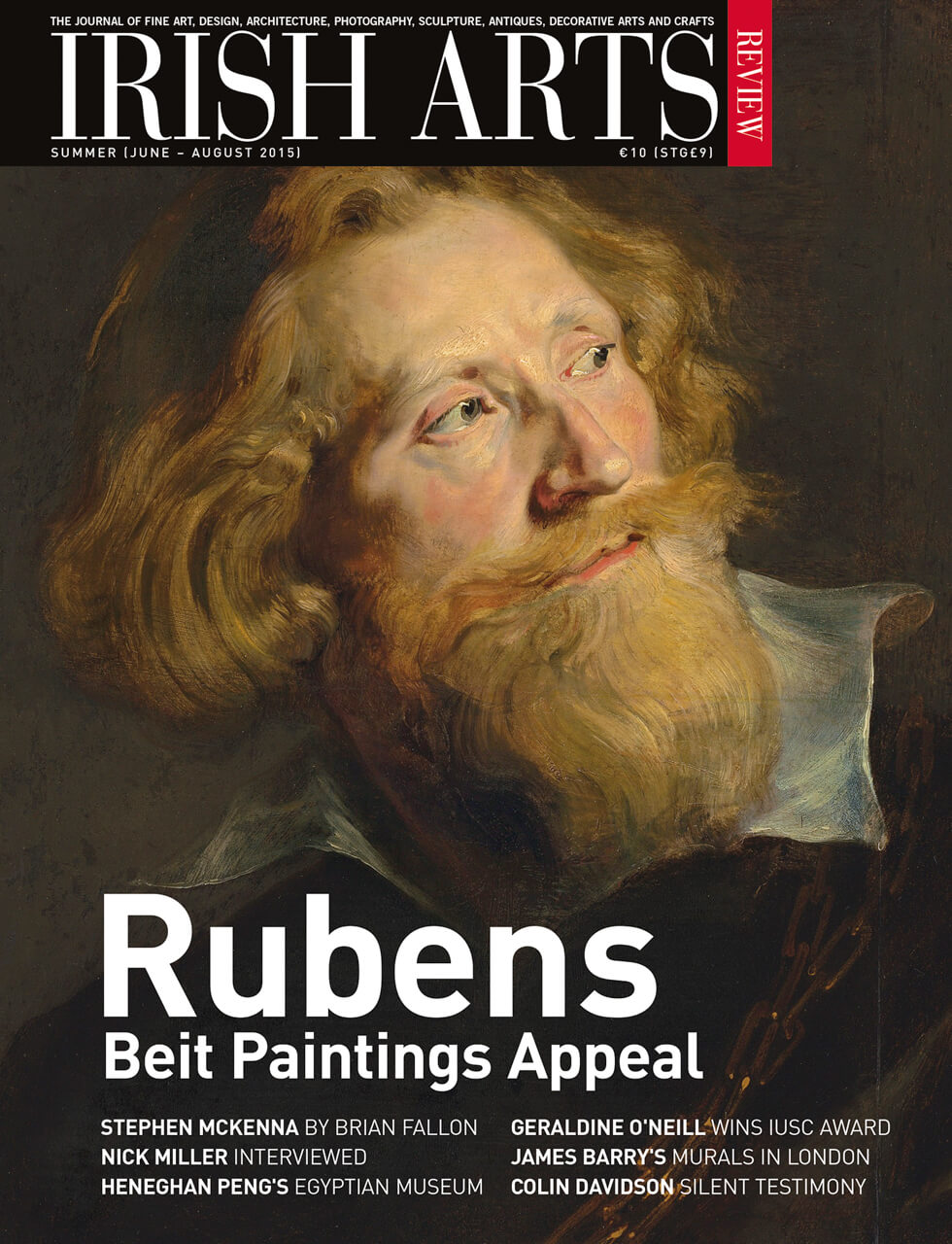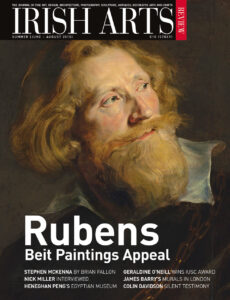

Seán Kissane reflects on the career of Gerda Fr√∂mel whose handling of form echoes Brancusi’s statement ‘Beauty is absolute equity.’
Gerda Fr√∂mel is among a group of German artists such as Joseph Beuys, Frank Auerbach, Eva Hesse and Georg Baselitz, whose work emerged from a post-war environment that sought to address themes of trauma and the body. Born in Czechoslovakia in 1931 to a family of German descent, her early experiences were marked by the Second World War and the ‘German Expulsions’ from the Sudetenland in its immediate aftermath. In 1945 her family were forced from their home and became refugees, settling firstly in Austria and finally in Stuttgart where Fr√∂mel enrolled in the Academy of Fine Arts in 1948. She went on to study metalwork and sculpture in Darmstadt and the Academy of Fine Arts in Munich.
While there she met the young sculptor Werner Sch√ºrmann. They married in 1955 and moved permanently to Ireland the following year as Sch√ºrmann had been offered a post teaching metalwork at the National College of Art. They lived in Woodtown Park, outside Rathfarnham where Sch√ºrmann established one of the only foundries in Ireland at the time and began to cast their works in bronze there. The foundry attracted other artists like James McKenna and Oisín Kelly who cast works there, and who soon became firm friends with the couple.
After 1956 Fr√∂mel participated annually in the ‘Irish Exhibition of Living Art’ (IELA) aligning herself with the most innovative artists in Ireland at the time. That year Fr√∂mel exhibited alongside Hilary Heron, Oisín Kelly, Frank Morris and Ian Stuart, artists who would be her peers for the next twenty years and their work forms a useful point of comparison when considering her later oeuvre.
A year later at the IELA she exhibited Johann Jacob Weneslaus (1957), a small portrait of her two-year-old son Wenzel that is typical of her production at the time (Fig 3). Fr√∂mel did not work the surface of the bronze to a fine polish but left the signs of her modelling clearly on the piece. Moreover, she did not clean away the remnants of the plaster following the casting process. Known as ‘investment’, this residue would normally be blasted out from the cracks in the bronze before it is patinated, but Fr√∂mel chose to leave it in place giving the sculpture a somewhat unfinished appearance, a style shared with the Italian sculptor Marino Marini. In the case of Johann Jacob Weneslaus the white investment creates highlights at points on the surface. With the child snuggly wrapped up in his hat and coat, the residue almost suggests that he has been out playing in the snow. Although different in scale, there are some similarities between the work of Edward Delaney and Fr√∂mel at this time, for example Delaney also leaves the white investment on the surface of his bronzes. Perhaps this affinity can be traced to their training in Germany, as Delaney had won a scholarship to study there in 1956.
The capacity to produce work in bronze set Fr√∂mel’s work apart from her contemporaries and gave her a competitive edge as she could produce fine objects relatively inexpensively at Woodtown. This was demonstrated by significant commissions and awards which she received at this stage in her career including Bord Fáilte (1960), Arts Council sculpture scholarship (1962), the Royal Institute of the Architects of Ireland award (1962), and a commission for a stained glass-window at St Brigid’s Cathedral, Kildare.
By 1964 Fr√∂mel had cemented her reputation in Ireland and that year she was offered a solo exhibition at the Dawson Gallery where Leo Smith showed the work of leading artists such as Nano Reid, Evie Hone, Louis le Brocquy, Brian King, Patrick Hickey, Micheal Farrell and others. At the time there were few opportunities to exhibit commercially in Dublin so this was a significant moment in Fr√∂mel’s career. The works she exhibited, bronzes and drawings, were based on observations from nature and the animals around Woodtown. These ‘animals’ were the most figurative works in the exhibition (Fig 6). The largest resembles a gazelle that has elongated limbs and horns that stretch horizontally along the length of its back. Animal Head depicts the skull and horns of a deer and like a trophy hanging in the hall of a country house it conveys a sense of displacement. The human appears in Little Figure (Fig 8) which shows the attenuation and elongation that we associate with the work of Alberto Giacometti (1901-1966) and it, along with Tree Heads is an almost direct quotation of his work. Newspaper clippings in Fr√∂mel’s archive show she was actively seeking out information about Giacometti’s work. It should be pointed out that in 1964 Giacometti was still alive and had not attained the near-mythical status he now holds. Giacometti’s practice had developed in Paris alongside the existentialism of Jean Paul Sartre and their work was ideologically phenomenological. Having come through the trauma of the war, enduring forced migration, economic hardship and the loss of her childhood home, Fr√∂mel aligned herself to this movement in order to assert the need for art to retain its relationship to the body and real experience.
In 1967 Fr√∂mel showed a series of sculptures at the Dawson quite different from 1964. The most striking feature is the departure from cast sculpture to works carved in stone. Sculptors are not always equally skilled in modelling and carving but in this exhibition Fr√∂mel demonstrated her virtuosity in both. As before the titles she used were simple: Disk, Pond and Landscape recur throughout and there is an elemental connection between them. In the early 1960s the American painter Morris Graves was living at Woodtown Manor, where he set up a small observatory at his house and he and Fr√∂mel spent evenings observing the movement of the stars and planets. She turned her observations into sculpture: the Sun becomes a bronze disc and the Moon a disc of alabaster that glows with cold reflected light. The land over which these celestial bodies float is suggested by the simplest line carved into the stone. Finally the moon’s reflection is seen on the water as a circle carved into Pond (Fig 7). The physical act of looking is felt: craning the neck to look upwards; turning the head from side to side to see the landscape; and glancing down at light reflected on water. These are subtle but powerful works and Louis le Brocquy praised their ‘articulate and delicately sensitive mati√®re’,1 while Desmond McAvock described them as ‘evanescent, glimmering, fossil-like’.2
Between 1967-70 Fr√∂mel commenced her most important commission Sails, made for the Carroll’s Factory in Dundalk, Co Louth. The architects Scott Tallon Walker’s original idea was to commission a major sculpture from Henry Moore or Alexander Calder and it is likely this would have been the outcome were it not for the intervention of the client who insisted that an Irish artist be commissioned.3 Fr√∂mel met with Ronald Tallon and proposed a mobile depicting sails for the site. The final stainless steel sculpture comprises three elements which resemble aircraft wings that move with the wind and proved Fr√∂mel’s capacity to work on a monumental scale. The successful completion of the sculpture attracted significant positive attention in the press and it became emblematic of the building. At that point it was the largest private sculptural commission in Ireland, and one that would stand up to international comparison.
In 1970 Fr√∂mel’s exhibition at the Dawson Gallery was met with a chorus of critical acclaim. Blathín O’Ciobhain declared it ‘superb’4 while PFB in the Evening Herald declared her ‘undoubtedly one of the best sculptors we have’.5 The exhibition was noted by the critics for the quality and variety of the ‘Heads’ exhibited. Although she had previously made portrait heads of her children, these were more archetypal. The head can be thought of as a container for the mind and imagination. It also references the Celtic and Germanic head cults – something that unites her origins and adopted home. She used a variety of materials from green alabaster (Fig 4) Connemara marble and Portuguese rose marble in their execution. Head (1970) executed in fine white veined marble is mask-like, carved in very low relief it is reminiscent of early Cycladic sculpture (Fig 5). A very different object is Head (1969), carved from green marble which has a very rough surface and unlike most of the others, does not have a base but lies on its side, a reference to the work of Constantin Brancusi (1876-1957). Other works which emerge in the early 1970s are made concurrently with the escalation of violence in Northern Ireland. Bloody Sunday took place in Derry in January 1972 and Ireland was changed irrevocably. For an artist whose work was phenomenological in temper and which was based on observations of life, such events could not go unmarked. As with her earlier Discs and Ponds that were sculptural translations of natural phenomena, her late works with titles such as Blade and Spear also relate to the real world (Fig 2). Blade was completed in 1974; it is a steel form that at almost two metres in height dwarfs the human viewer. On a biographical level, one imagines the teenage Fr√∂mel being forced from her home and when confronted by bayonets and rifles how horrific they must have seemed.
In August 1975 the life of this extraordinary woman was cut short when she died in a drowning accident. Among the artistic community the news of her untimely death at the age of 44 was greeted with shock. At the IELA that year a special display was made of her work and the catalogue included a tribute to her. A year later a substantial retrospective of Fr√∂mel’s work was held at the Municipal Gallery. After 1976 her work continued to be championed by writers like Dorothy Walker and was included in ‘Rosc 1980′ but was rarely exhibited. Her work is held in many public collections and IMMA has been fortunate in recent years in being offered works from the Carroll’s Collection as well as the Bank of Ireland and so now has the most substantial holding of Fr√∂mel’s work in a public collection. They have been included in landmark exhibitions such as ‘The Moderns’ (2010-2011) ensuring that her work continues to be considered within the canon of Irish and international Modernism. It is hoped that with this exhibition untraced works will be recognized by their owners and brought to our attention so that a more complete catalogue raisonné can be written in the future.
‘Gerda Fr√∂mel: A Retrospective’ FE McWilliam Gallery, Banbridge, 25 July-10 October 2015.
Seán Kissane is Curator of Exhibitions at IMMA.
1 Letter from Louis le Brocquy, 3 December 1967, Schürmann family archive.
2 Desmond McAvock, ‘Exhibition of drawings and sculpture’, The Irish Times, 30 September 1967.
3 Ronald Tallon interviewed by Vera Ryan, Irish Art of the Seventies, (Cork, Crawford Art Gallery, 2007, p47.
4 Blathín O Ciobhain, The Irish Times, 9 October 1970.



